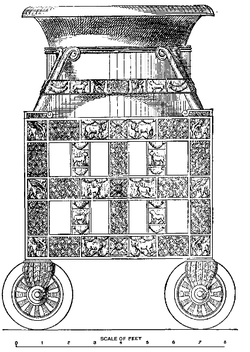
The Septuagint, sometimes referred to as the Greek Old Testament or The Translation of the Seventy, and often abbreviated as LXX, is the earliest extant Greek translation of the Hebrew Bible from the original Hebrew. The full Greek title derives from the story recorded in the Letter of Aristeas to Philocrates that "the laws of the Jews" were translated into the Greek language at the request of Ptolemy II Philadelphus by seventy-two Hebrew translators—six from each of the Twelve Tribes of Israel.

The Masoretic Text is the authoritative Hebrew and Aramaic text of the 24 books of the Hebrew Bible (Tanakh) in Rabbinic Judaism. The Masoretic Text defines the Jewish canon and its precise letter-text, with its vocalization and accentuation known as the mas'sora. Referring to the Masoretic Text, masorah specifically means the diacritic markings of the text of the Jewish scriptures and the concise marginal notes in manuscripts of the Tanakh which note textual details, usually about the precise spelling of words. It was primarily copied, edited, and distributed by a group of Jews known as the Masoretes between the 7th and 10th centuries of the Common Era (CE). The oldest known complete copy, the Leningrad Codex, dates from the early 11th century CE.

The Molten Sea or Brazen Sea was a large basin in the Temple in Jerusalem made by Solomon for ablution of the priests. It is described in 1 Kings 7:23–26 and 2 Chronicles 4:2–5. It stood in the south-eastern corner of the inner court. According to the Bible it was five cubits high, ten cubits in diameter from brim to brim, and thirty cubits in circumference. The brim was like the rim of a cup or like a lily blossom, and its thickness was a hand breadth", three or four inches. It was placed on the backs of twelve oxen, standing with their faces outward. It was capable of containing two or three thousand baths of water. The fact that it was a wash basin which was too large to enter from above lends to the idea that water would likely have flowed from it down into a subcontainer beneath. The water was originally supplied by the Gibeonites, but was afterwards brought by a conduit from Solomon's Pools. The "molten sea" was made of brass or bronze, which Solomon had taken from the captured cities of Hadarezer, the king of Zobah. Ahaz later removed this laver from the oxen, and placed it on a stone pavement. It was destroyed by the Chaldeans.

An ephod was a type of apron that, according to the Hebrew Bible, was worn by the High Priest of Israel, an artifact and an object to be revered in ancient Israelite culture, and was closely connected with oracular practices and priestly ritual.
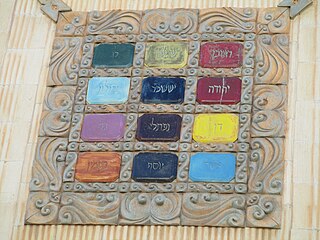
The priestly breastplate or breastpiece of judgment was a sacred breastplate worn by the High Priest of the Israelites, according to the Book of Exodus. In the biblical account, the breastplate is termed the breastplate of judgment, because the Urim and Thummim were placed upon it. These elements of the breastplate are said in the Exodus verse to carry the judgment of God concerning the Israelites at all times.
According to the Torah, Gershon was the eldest of the sons of Levi, and the patriarchal founder of the Gershonites, one of the four main divisions among the Levites in biblical times. The Gershonites were charged with the care of the outer tabernacle including components such as the tent and its covering, screens, doors, and hangings. Biblical scholars regard the name as being essentially the same as "Gershom", which appears to mean "a sojourner there", and it is Gershom rather than Gershon who is sometimes listed in the Book of Chronicles as a founder of one of the principal Levite factions. The Torah names Gershon's sons as Libni and Shimei.
In the Bible, the Cherethites and Pelethites, the former also spelled Kerethites, are two ethnic groups in the Levant. Their identity has not been determined with certainty. The Cherethites are mentioned independently three times, and as the "Cherethites and Pelethites" seven times. They are interpreted to have been a group of elite mercenaries employed by King David, some of whom acted as his bodyguards, and others as part of his army.

Kosher animals are animals that comply with the regulations of kashrut and are considered kosher foods. These dietary laws ultimately derive from various passages in the Torah with various modifications, additions and clarifications added to these rules by halakha. Various other animal-related rules are contained in the 613 commandments.
There is no scholarly consensus as to when the canon of the Hebrew Bible was fixed. Rabbinic Judaism recognizes the twenty-four books of the Masoretic Text as the authoritative version of the Tanakh. Of these books, the Book of Daniel of Ketuvim has the most recent final date of composition. The canon was therefore fixed at some time after this date. Some scholars argue that it was fixed during the Hasmonean dynasty, while others argue it was not fixed until the second century CE or even later.
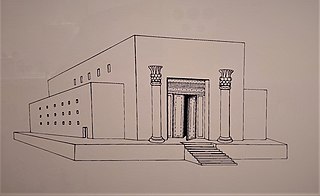
Solomon's Temple, also known as the First Temple, was a biblical Temple in Jerusalem believed to have existed between the 10th and 6th centuries BCE. Its description is largely based on narratives in the Hebrew Bible, in which it was commissioned by biblical king Solomon before being destroyed during the Siege of Jerusalem by Nebuchadnezzar II of the Neo-Babylonian Empire in 587 BCE. No remains of the destroyed temple have ever been found. Most modern scholars agree that the First Temple existed on the Temple Mount in Jerusalem by the time of the Babylonian siege, and there is significant debate among scholars over the date of its construction and the identity of its builder.
The Samuel scroll is a collection of four manuscript fragments containing parts of the Book of Samuel which were found among the Dead Sea Scrolls.

1 Kings 7 is the seventh chapter of the Books of Kings in the Hebrew Bible or the First Book of Kings in the Old Testament of the Christian Bible. The book is a compilation of various annals recording the acts of the kings of Israel and Judah by a Deuteronomic compiler in the seventh century BCE, with a supplement added in the sixth century BCE. This chapter belongs to the section focusing on the reign of Solomon over the unified kingdom of Judah and Israel. The focus of this chapter is the reign of Solomon, the king of Israel.
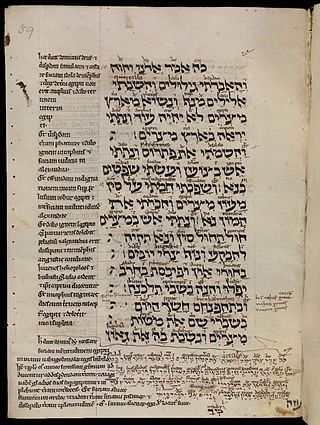
Ezekiel 41 is the forty-first chapter of the Book of Ezekiel in the Hebrew Bible or the Old Testament of the Christian Bible. This book contains the prophecies attributed to the prophet/priest Ezekiel, and is one of the Books of the Prophets. The Jerusalem Bible refers to the final section of Ezekiel, chapters 40-48, as "the Torah of Ezekiel". This chapter continues Ezekiel's vision of a future Temple.

Ezekiel 45 is the forty-fifth chapter of the Book of Ezekiel in the Hebrew Bible or the Old Testament of the Christian Bible. This book contains the prophecies attributed to the prophet/priest Ezekiel, and is one of the Books of the Prophets. The final section of Ezekiel, chapters 40-48, give the ideal picture of a new temple. The Jerusalem Bible refers to this section as "the Torah of Ezekiel". In particular, chapters 44–46 record various laws governing the rites and personnel of the sanctuary, as a supplement to Ezekiel's vision.

Jeremiah 8 is the eighth chapter of the Book of Jeremiah in the Hebrew Bible or the Old Testament of the Christian Bible. This book contains prophecies attributed to the prophet Jeremiah and is one of the Books of the Prophets. Chapters 7 to 10 constitute an address delivered by Jeremiah at the gate of the Temple in Jerusalem.
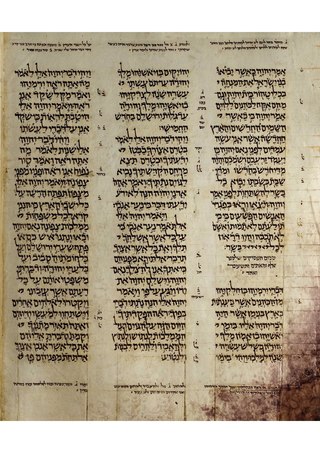
Jeremiah 27 is the twenty-seventh chapter of the Book of Jeremiah in the Hebrew Bible or the Old Testament of the Christian Bible. The material found in Jeremiah 27 is found in Jeremiah 34 in the Septuagint, which orders some material differently. This book contains prophecies attributed to the prophet Jeremiah, and is one of the Books of the Prophets. The New American Bible (NABRE) describes chapters 27-29 as "a special collection of Jeremiah’s prophecies dealing with false prophets", and suggests that "stylistic peculiarities evident in the Hebrew suggest that these three chapters once existed as an independent work".

2 Chronicles 4 is the fourth chapter of the Second Book of Chronicles the Old Testament of the Christian Bible or of the second part of the Books of Chronicles in the Hebrew Bible. The book is compiled from older sources by an unknown person or group, designated by modern scholars as "the Chronicler", and had the final shape established in late fifth or fourth century BCE. This chapter belongs to the section focusing on the kingship of Solomon. The focus of this chapter is the construction of the temple's interior decoration.
